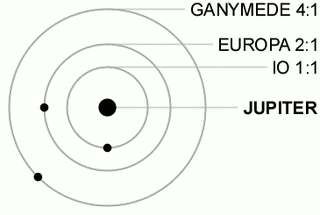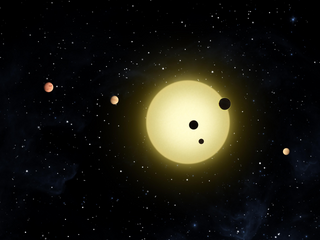Related Research Articles

In celestial mechanics, orbital resonance occurs when orbiting bodies exert regular, periodic gravitational influence on each other, usually because their orbital periods are related by a ratio of small integers. Most commonly, this relationship is found between a pair of objects. The physical principle behind orbital resonance is similar in concept to pushing a child on a swing, whereby the orbit and the swing both have a natural frequency, and the body doing the "pushing" will act in periodic repetition to have a cumulative effect on the motion. Orbital resonances greatly enhance the mutual gravitational influence of the bodies. In most cases, this results in an unstable interaction, in which the bodies exchange momentum and shift orbits until the resonance no longer exists. Under some circumstances, a resonant system can be self-correcting and thus stable. Examples are the 1:2:4 resonance of Jupiter's moons Ganymede, Europa and Io, and the 2:3 resonance between Neptune and Pluto. Unstable resonances with Saturn's inner moons give rise to gaps in the rings of Saturn. The special case of 1:1 resonance between bodies with similar orbital radii causes large planetary system bodies to eject most other bodies sharing their orbits; this is part of the much more extensive process of clearing the neighbourhood, an effect that is used in the current definition of a planet.

A circumbinary planet is a planet that orbits two stars instead of one. The two stars orbit each other in a binary system, while the planet typically orbits farther from the center of the system than either of the two stars. In contrast, circumstellar planets in a binary system have stable orbits around one of the two stars, closer in than the orbital distance of the other star. Studies in 2013 showed that there is a strong hint that a circumbinary planet and its stars originate from a single disk.

Kepler-9 is a sunlike star in the constellation Lyra. Its planetary system, discovered by the Kepler Mission in 2010 was the first detected with the transit method found to contain multiple planets.

Kepler-11, also designated as 2MASS J19482762+4154328, is a Sun-like star slightly larger than the Sun in the constellation Cygnus, located some 2,110 light years from Earth. It is located within the field of vision of the Kepler spacecraft, the satellite that NASA's Kepler Mission uses to detect planets that may be transiting their stars. Announced on February 2, 2011, the star system is among the most compact and flattest systems yet discovered. It is the first discovered case of a star system with six transiting planets. All discovered planets are larger than Earth, with the larger ones being about Neptune's size.

Kepler-11b is an exoplanet discovered around the star Kepler-11 by the Kepler spacecraft, a NASA-led mission to discover Earth-like planets. Kepler-11b is less than about three times as massive and twice as large as Earth, but it has a lower density, and is thus most likely not of Earth-like composition. Kepler-11b is the hottest of the six planets in the Kepler-11 system, and orbits more closely to Kepler-11 than the other planets in the system. Kepler-11b, along with its five counterparts, form the first discovered planetary system with more than three transiting planets—the most densely packed known planetary system. The system is also the flattest known planetary system. The discovery of this planet and its five sister planets was announced on February 2, 2011, after follow-up investigations.

Kepler-223 is a G5V star with an extrasolar planetary system discovered by the Kepler mission. Studies indicate that the Kepler-223 star system consists of 4 planets orbiting the star.
Kepler-80, also known as KOI-500, is a red dwarf star of the spectral type M0V. This stellar classification places Kepler-80 among the very common, cool, class M stars that are still within their main evolutionary stage, known as the main sequence. Kepler-80, like other red dwarf stars, is smaller than the Sun, and it has both radius, mass, temperatures, and luminosity lower than that of our own star. Kepler-80 is found approximately 1,223 light years from the Solar System, in the stellar constellation Cygnus, also known as the Swan.

Kepler-90, also designated 2MASS J18574403+4918185, is a F-type star located about 2,790 light-years (855 pc) from Earth in the constellation of Draco. It is notable for possessing a planetary system that has the same number of observed planets as the Solar System.
Kepler-30 is a star in the northern constellation of Lyra. It is located at the celestial coordinates: Right Ascension 19h 01m 08.0747s Declination +38° 56′ 50.219″. With an apparent visual magnitude of 15.5, this star is too faint to be seen with the naked eye. Kepler-30 is exhibiting a strong starspot activity.
Kepler-31 is a star in the northern constellation of Cygnus, the swan. It is orbited by three known exoplanets. It is located at the celestial coordinates: Right Ascension 19h 36m 05.5270s, Declination +45° 51′ 11.106″. With an apparent visual magnitude of 14.0, this star is too faint to be seen with the naked eye.
Kepler-29 is a Sun-like star in the northern constellation of Cygnus. It is located at the celestial coordinates: Right Ascension 19h 53m 23.6020s, Declination +47° 29′ 28.436″. With an apparent visual magnitude of 15.456, this star is too faint to be seen with the naked eye. It is a solar analog, having a close mass, radius, and temperature as the Sun. Currently the age of the star has not been determined due to its 2780 light-year distance. As of 2016 no Jovian exoplanets of 0.9–1.4 MJ have been found at a distance of 5 AU.

K2-138, also designated EPIC 245950175 or EE-1, is a large early K-type main sequence star with a system of at least 6 planets discovered by citizen scientists. Four were found in the first two days of the Exoplanet Explorers project on Zooniverse in early April 2017, while two more were revealed in further analysis. The system is about 660 light-years away in the constellation Aquarius, within K2 Campaign 12.
K2-19 is an early K-type or late G-type main sequence star that is magnetically active, and has a light curve that exhibits variations in brightness of ~1%. It is located approximately 976 light-years away in the constellation Virgo. Three confirmed transiting exoplanets are known to orbit this star.
K2-32 is a G9-type main sequence star slightly smaller and less massive than the sun. Four confirmed transiting exoplanets are known to orbit this star. A study of atmospheric escape from the planet K2-32b caused by high-energy stellar irradiation indicates that the star has always been a very slow rotator.
Kepler-160 is a main-sequence star approximately the width of our Galactic arm away in the constellation Lyra, first studied in detail by the Kepler Mission, a NASA-led operation tasked with discovering terrestrial planets. The star, which is very similar to the Sun in mass and radius, has three confirmed planets and one unconfirmed planet orbiting it.
K2-24 is a metal-rich G3-type main sequence star larger and more massive than the Sun, located 560 light-years away in the constellation Scorpius. Two confirmed transiting exoplanets are known to orbit this star. An attempt to detect stellar companions using adaptive optics imaging at the Keck telescope was negative however later observations using lucky imaging at the Danish 1.54 m telescope at La Silla Observatory detected a possible companion at 3.8 arcseconds distance from K2-24. This candidate companion being over 8 magnitudes fainter than K2-24 and with a color temperature of 5400 Kelvin, is inconsistent with a bound main sequence companion.
TOI-1136 is a G-type main-sequence star 276 light-years away in the constellation Draco. It is slightly smaller than the Sun and similar in mass and temperature, but is much younger, with an age of about 700 million years. It hosts a system of at least six, and possibly seven, exoplanets.
HD 110067 is a star with six known sub-Neptune exoplanets with radii ranging from 1.94 R⊕ to 2.85 R⊕. The planets orbit the host star in a rhythmic orbital resonance. The star, and related planetary system, is located 105 light-years away in the constellation Coma Berenices.
References
- 1 2 3 4 5 6 7 8 9 10 11 12 13 14 15 16 17 18 19 20 21 Leleu, A.; Alibert, Y.; Hara, N. C.; Hooton, M. J.; Wilson, T. G.; Robutel, P.; Delisle, J.-B.; Laskar, J.; Hoyer, S.; Lovis, C.; Bryant, E. M.; Ducrot, E.; Cabrera, J.; Delrez, L.; Acton, J. S.; Adibekyan, V.; Allart, R.; Prieto, Allende; Alonso, R.; Alves, D.; et al. (2021-01-20). "Six transiting planets and a chain of Laplace resonances in TOI-178". Astronomy & Astrophysics. 649: A26. arXiv: 2101.09260 . Bibcode:2021A&A...649A..26L. doi:10.1051/0004-6361/202039767. ISSN 0004-6361. S2CID 231693292.
- ↑ Roman, Nancy G. (1987). "Identification of a Constellation From a Position". Publications of the Astronomical Society of the Pacific. 99 (617): 695–699. Bibcode:1987PASP...99..695R. doi: 10.1086/132034 . S2CID 120559848.. Requête spécifique à TOI-178 sur VizieR.
- 1 2 Plait, Phil (2021-01-25). "A six-planet system dances in time to the tune of gravity". SYFY WIRE. Retrieved 2021-01-27.
- 1 2 "Nearby Orange Dwarf Hosts Unique System of Six Planets | Astronomy | Sci-News.com". Breaking Science News | Sci-News.com. Retrieved 2021-01-27.



